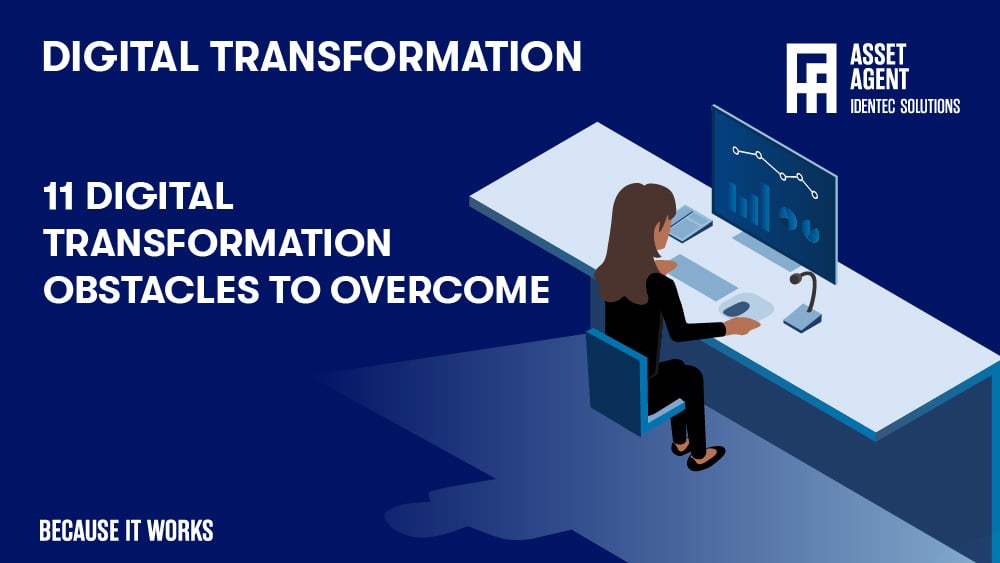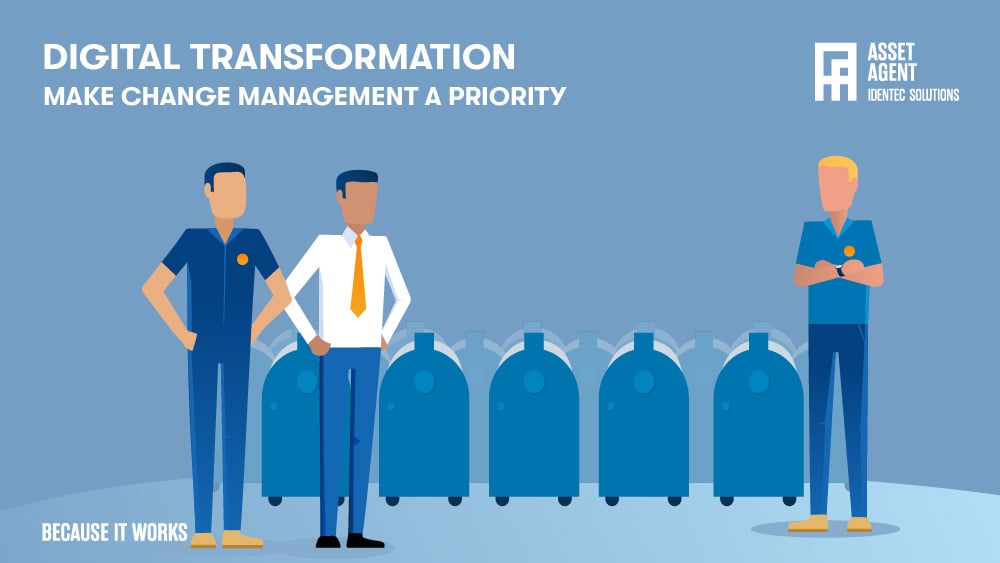11 Digital Transformation Challenges and how to overcome them
| Written by Mark Buzinkay
In an era of swift technological progress, digital transformation is vital for businesses. As they adapt to this digital age, they'll face challenges requiring effective navigation.
This shift impacts every aspect of an organization, not only adopting new technologies but necessitating substantial change management in business operations, customer engagement and value delivery.
Change management is, therefore, essential for digital transformation success - it's about aiding individuals and teams in embracing changes. Given the magnitude and speed of digital transformation, change management, very often called a 'soft discipline', becomes even more pivotal and complex.
Understanding these challenges can streamline the path to digital transformation. Though the journey is demanding, with strategic planning and adept change management, businesses can achieve lasting success in the digital landscape.

No video selected
Select a video type in the sidebar.
Table of contents:
- Why Is Digital Transformation Difficult?
- What are the 11 Obstacles of Digital Transformation?
- Strategies to Tackle Digital Transformation Hurdles
- Takeaway
- Glossary
Why Is Digital Transformation Difficult?
Digital transformation is not only adopting new software, technologies, and processes that are more efficient and automated than traditional business practices and processes but also an entirely new, innovative way of doing something that is core to your business.
That means organizations must consider everything when taking on a digital transformation initiative – from how people will react to the change, how it will impact customer relations, the cost, how it will align with business goals, etc. Digital transformations empower organizations to take their business into the future, position companies to withstand competition, and grow into new areas.
Digital transformation is difficult for several reasons, including:
- Complexity: Digital transformation entails updating legacy applications and merging diverse technologies, processes, and strategies, which can be complex and tough to oversee.
- Strategic clarity: Crafting a coherent digital strategy in sync with an organization's primary objectives can be daunting, and a lack of clear vision or leadership can stall initiatives.
- Organizational hurdles: Adapting to change can be unsettling, and there might be pushback from employees familiar with conventional methods, complicating the integration of new systems and technologies.
- Shifting dynamics: The ever-evolving digital realm poses challenges for organizations trying to stay updated with emerging tech and market shifts.
- Talent deficit: There is often a notable lack of professionals with the necessary expertise for digital transformation, which presents an organizational talent challenge.
- Assessing outcomes: Determining the ROI of digital transformation initiatives is intricate, as the advantages might not be instantly visible or straightforward to measure.
- Outdated systems: Aging infrastructure can obstruct the introduction of contemporary technologies, resulting in technical liabilities and transition issues.
- Security issues: While safeguarding data and adhering to privacy norms is vital in digital transformation, it's often tough to ensure and sustain.
- Limited resources: Digital transformation demands considerable resources, which might be scarce, especially for smaller enterprises.

What are the 11 Obstacles of Digital Transformation?
1) Absence of a clear strategy
Digital transformation is more than just a trendy term. However, it's frequently used without a precise meaning. This causes businesses to navigate uncertain terrains, aware of the need to progress but unclear about the direction.
Lacking a strategy, your transformation might stall. Reflect on this: What are my organization's objectives and focal points? Are they uniform throughout the company, or are certain stakeholders misaligned?
2) Change-resistant corporate culture
A corporate culture opposing change hinders evolution and progress. Yet, this change-resistant mindset regarding digital transformation is observable in numerous enterprises. From top-tier executives to ground-level staff, there's a degree of reluctance to embrace new tech. Some leaders might not see the merit in altering established practices, especially if they're yielding positive outcomes. Workers might be apprehensive about the evolving roles and duties accompanying digital transformation. Neglecting these concerns means potentially missing out on pivotal growth chances.
3) Deficiency in organizational change management
Educating staff on novel tools is daunting, but when resistance to change is added, digital transformation seems even more daunting.
Thankfully, emphasizing organizational change management can assist your business in readying employees for upcoming changes - and this goes beyond just the technical aspects of digital transformation: it's vital to address the individuals it impacts by crafting a thorough change management strategy.
4) Compartmentalized decision-making
Institutional silos are detrimental to digital transformation, creating hurdles in almost every transformation facet, from strategy formulation to execution.
Silos result in fragmented decision-making, with each unit or department targeting its unique challenges and goals. This is further complicated by the absence of a cohesive vision guiding every team towards a unified business objective, limiting efficiency and stifling innovation.
5) Shifting customer expectations
Today's consumers are more selective and have higher demands (not only in B2C!). Features like contactless access control have transitioned from being luxury high-security choices to standard expectations for doors.
Instead of presuming you're aware of the tech solutions your clients desire, it's advisable to invest time in market analysis, understand their actual preferences and observe the strategies competitors employ to captivate them.
6) Emerging digital skill shortage
At the core of every triumphant digital transformation lies a committed, proficient IT squad. Yet, assembling such a squad is becoming more challenging. Even roles not inherently tech-focused will require basic technological understanding (learn more about digital transformation tools here). This results in a lack of the broad spectrum of digital skills essential for a successful transformation.
With the rise in businesses adopting contemporary and cutting-edge technologies, there's a growing talent gap. Recruiting and retaining individuals with digital expertise, like: Cybersecurity, system architecture, corporate architecture, sophisticated data analysis, adherence to recent regulations, such as the General Data Protection Regulation (GDPR), handling risks linked to novel technologies.
7) Financial limitations and concerns
A prevalent challenge when lacking a distinct strategy is the struggle with budgeting.
Scope expansion is typical as you adapt to customization demands and shifting consumer requirements. Without a strategy, you risk making choices that offer minimal value but inflate your budget and extend your timeline.
Consequently, it's advisable to focus on the long-term objectives of your transformation and use these benchmarks to formulate a feasible project blueprint along the journey. This requires a deep understanding of the digital processes and tools you're adopting and the organizational culture they're being integrated into.
Companies that endured substantial setbacks during global crises might have postponed digital transformation due to monetary restrictions. Why? The truth is, initiating new digital endeavours is a costly venture demanding significant capital.
There's also a misconception that tech spending is merely an operational cost when companies don't view digital transformation as a strategic expenditure: they tend to allocate insufficient funds, which in turn, obstructs proper execution and future flexibility.
8) Outdated business operations
Do your existing business procedures mirror the expansion you anticipate for your company?
If they don't, modifications to workflows, business regulations, and data utilization might be necessary, differing from what you had planned with your traditional systems.
9) Poor data handling
Trustworthy data is a cornerstone of digital transformation, but yet, data challenges are rampant in numerous firms.
For instance, dealing with compartmentalized systems can make data amalgamation for central access challenging.
Consequently, to avert data-related problems, it's crucial to establish a data blueprint prior to software selection, ensuring that you're aware of the data that needs cleaning, normalization, and transfer to the new system, enabling it to provide essential insights.
A data blueprint can also guide you in recognizing new data sources that might enhance the insights from your new software. For example, adopting IoT solutions (like Asset Agent) can offer insights like equipment health and operational time.
10) Deficit of tech resources
Beyond the talent crunch, today's businesses also grapple with a lack of other vital resources for digital initiative adoption. Issues like global microchip shortages continue to obstruct various sectors. Additionally, challenges persist in the supply chain for IT equipment and hardware. This scarcity delays the prompt allocation of necessary resources to pertinent projects.
11) Escalating security threats
In their rush to cater to rapidly changing consumer needs, several firms hastily introduced digital solutions, exposing them to heightened cybersecurity threats. This has made other companies cautious about potential vulnerabilities when launching their initiatives.
Such apprehensions are not baseless. Collaborating with multiple SaaS providers is a complex endeavour. Ensuring the security standards of each third-party tool and platform is a formidable task, even for firms with a robust tech development team.

Strategies to Tackle Digital Transformation Hurdles
Here are seven tactics businesses can employ to navigate digital transformation challenges and harness the power of modern digital systems.
1) Synchronize business objectives with transformation strategy
Why is your organization undergoing digital transformation? This rationale should guide your endeavours. Recognize customer requirements, challenges, and friction points. Scrutinize existing processes to spot legacy systems needing upgrades.
Ultimately, your transformation should resonate with your primary business objectives, enhancing employee efficiency, elevating customer experiences, and boosting revenue (read more about a digital transformation plan for industrial manufacturing)
2) Form a change leadership team
Examine your workforce to pinpoint influential, innovative, and reliable individuals. Assemble a diverse team from these standout contributors to guide your digital transformation. This team will craft a vision for your transformation that resonates with business objectives and stems from those familiar with your company's core.
This proactive stance emphasizes the human side of change, propelling digital transformation forward.
3) Engage a digital transformation expert
Not all changes equate to a full-blown digital transformation. Given its comprehensive nature, many organizations unfamiliar with such a shift feel daunted.
Engaging a digital transformation consultancy offers the assurance of seasoned professionals. They'll equip you with a proven framework for success.
4) Stay agile
Digital transformation inherently implies organizational adaptability. With the swift evolution of technology, agility is paramount.
Being agile entails embracing change. Seize emerging opportunities. The very act of undergoing digital transformation signifies agility—embrace this shift, welcoming new tools and methodologies.
5) Solicit employee feedback
Valuing employee feedback fosters a collaborative, engaged workforce, which is crucial for navigating digital transformation. Engaging employees, understanding their perspectives, and anticipating challenges lead to more refined solutions.
When employees feel valued and involved, they're more inclined to adopt new technologies, accelerating digital transformation success and will likely work in an agile way.
6) Consistently monitor and adjust
Given the continuous nature of digital transformation, regular oversight and evaluation are vital (see above "stay agile"). A system for ongoing assessment enables organizations to pinpoint and rectify shortcomings swiftly. This vigilance ensures alignment with business objectives, efficient resource utilization, and timely issue resolution.
In essence, consistent oversight ensures a smoother, more sustainable digital transformation, keeping businesses agile in a dynamic digital world.
Takeaway
In today's rapidly evolving technological landscape, digital transformation is no longer a luxury but a necessity for businesses. This transformation goes beyond just integrating new technologies; it demands a holistic shift in business operations, customer interactions, and value propositions. Central to this shift is change management, a crucial yet often underestimated component. It focuses on helping individuals and teams adapt to these changes. As the pace and scope of digital transformation intensify, the role of change management becomes increasingly critical. By recognizing and addressing these challenges head-on, and with well-strategized change management, businesses can navigate the complexities of digital transformation and secure a prosperous future in the digital era.
Dive deeper into one of our core topics: Digital Transformation
Glossary
Corporate culture refers to the shared values, beliefs, behaviours, and norms that define how people within an organization interact and work. It influences decision-making, communication, and overall organizational effectiveness. A strong corporate culture aligns employees with company goals, enhances motivation, and fosters a positive work environment. It plays a crucial role in shaping identity, guiding actions, and sustaining long-term success. (2)
Sources:
(1) Henriette, Emily; Feki, Mondher; and Boughzala, Imed: Digital Transformation Challenges (2016). MCIS 2016 Proceedings. 33. https://aisel.aisnet.org/mcis2016/33
(2) Schein, E. H. (2010). Organizational Culture and Leadership (4th ed.). Jossey-Bass.
Note: This article was updated on the 13th of August 2025. This article was partly created with the assistance of artificial intelligence to support drafting. The head image was generated by AI.

Author
Mark Buzinkay, Head of Marketing
Mark Buzinkay holds a PhD in Virtual Anthropology, a Master in Business Administration (Telecommunications Mgmt), a Master of Science in Information Management and a Master of Arts in History, Sociology and Philosophy. Mark spent most of his professional career developing and creating business ideas - from a marketing, organisational and process point of view. He is fascinated by the digital transformation of industries, especially manufacturing and logistics. Mark writes mainly about Industry 4.0, maritime logistics, process and change management, innovations onshore and offshore, and the digital transformation in general.




